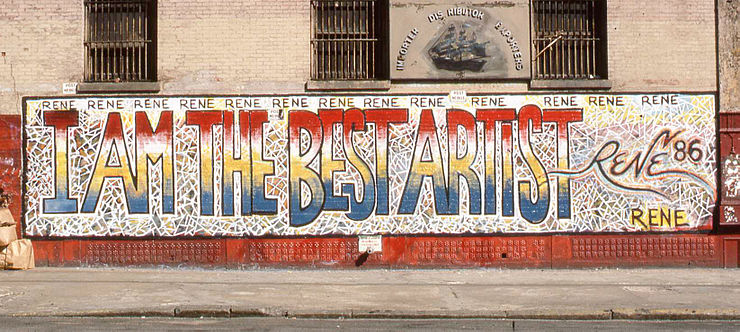Above: Mural by Rene Moncada on West Broadway between Spring & Broome Streets, 1986
On January 20, 1971, the City Planning Commission voted 4 to 0 to recommend to the Board of Estimate that artists be permitted to reside in the manufacturing buildings of SoHo. On January 28, the Board of Estimate made that recommendation law. This law was ultimately passed due to the SoHo Artists’ Association’s two-year battle with the city for the legalization of loft living in SoHo and set a precedent for how other neighborhoods and cities would approach adaptive reuse of non-residential urban areas. Then, on January 29, the question on everyone’s mind was, what is an artist? What are the criteria to qualify as an artist? Who will decide who is an artist and who is not? Parameters had to be drawn around an amorphous, murky area that defied confinement.
Because the law was meant to keep fine artists in affordable spaces in SoHo and to keep others, including commercial artists who could afford market rents, out, the definition of an artist for these purposes had to take this into account. First of all, unlike in the art world in general, artist certification in SoHo was not based on the quality of work, but on commitment to work, on the seriousness and duration of one’s involvement, no matter what medium. Certification was also determined by a need for space. According to the February 10, 1971 SoHo Newsletter, one’s status as an artist was to be determined by the following:
- A description of the artist’s work.
- A description of the artist’s need for space.
- A biographical sketch including data the artist feels is pertinent; education, professional training, public exhibitions or performances, reviews, or grants.
- Other data. If the artist does not feel properly represented by 1, 2, or 3, above, he can: a) present documentation of his work n the form of slides, photographs or other data which will back up his commitment and space needs—but not his aesthetics, or b) ask a few members of the Committee to visit his studio or working space to discuss his situation.
- The names of two people who are familiar with the artist’s work and who can testify to his commitment and his need for loft space.
The Criteria Committee that judged applications consisted of 20 people, 10 artists and 10 non-artists who have been active in an arts-related organization. The non-artists were included to prevent decisions biased toward aesthetic considerations. There was also an appeals committee, a de-certification procedure to “defrock” applicants who were wrongly certified, and a re-certification process, where artists needed to renew their status, as attrition in their line of work was (and still is) quite high.
These criteria were carefully developed to ensure that SoHo lofts were reserved for committed artists, including those whose work was not well-known, well-liked, or well-bought. As the film and theater director Joellen Johnson, who was very active in drawing up the guidelines for artists, stated, “If you work big in peanut butter and matchsticks, you’ll be ok.”
No system, no matter how well-intentioned, is perfect, however. My friend, a SoHo resident since 1977 and lifelong composer and musician in multiple musical genres, applied for certification when the Loft Law was passed. In the first go-around, his application was rejected because being a rock and roll musician was considered the equivalent of being a commercial graphic artist and rock music was not considered a fine art for the purposes of the application. So my friend resubmitted his application, this time removing all references to his gigs in rock clubs, and asked a couple of established musicians to write letters on his behalf. He played up the fact that he composed music for dancers and played jazz, which was considered a fine art. And, lo and behold, he was accepted and has lived in the same loft for 35 years now.
Until the Loft Law was made permanent two years ago, however, my friend, like many others in his situation, was living in a kind of limbo because there was a chance that, once expired, the Loft Law might not be renewed. As a result, he and other long-time SoHo residents living under the Law never felt that they could invest much into their lofts because they could possibly lose them at any time. Once the law was made permanent, they were able to breathe a sign of relief and finally begin settling in (after 33 years!).
Even in the beginning, there were non-artists who slipped in through the cracks and legitimate artists who were rejected, and as time went on, things began to get more and more loosey goosey until the present day, when the Loft Law is still in effect, but there are only a few hundred artists remaining in SoHo, at best. Every non-artist who moves into SoHo could still be told to move out unless he or she can prove artistic legitimacy, but the probability of that aspect of the law being enforced is close to nil. And what IS an artist these days anyway? An investment banker could also describe himself as a financial expressionist, a book editor could say she is a literary choreographer, and a rock guitarist could claim to be a musician. What has this world come to?

